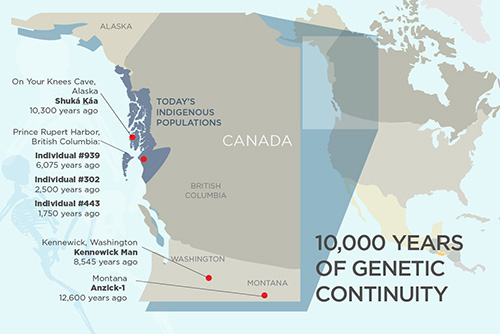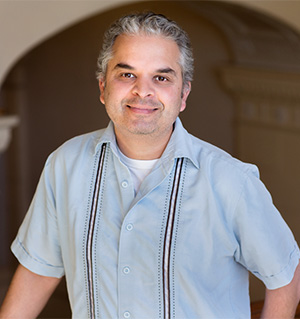
Study reveals 10,000 years of genetic continuity in northwest North America
April 05, 2017
Wednesday PM
(SitNews) - A study of the DNA in ancient skeletal remains adds to the evidence that indigenous groups living today in southern Alaska and the western coast of British Columbia are descendants of the first humans to make their home in northwest North America more than 10,000 years ago.
"Our analysis suggests that this is the same population living in this part of the world over time, so we have genetic continuity from 10,000 years ago to the present," said University of Illinois anthropology professor Ripan Malhi, who led the study with University of Chicago postdoctoral researcher John Lindo; Penn State University biology professor Michael DeGiorgio; Rosita Worl, the director of the Sealaska Heritage Institute in Juneau, Alaska; and University of Oklahoma anthropology professor Brian Kemp.

Click here or on the graphic for a larger image
Researchers are analyzing DNA from ancient individuals found in southeast Alaska, coastal British Columbia, Washington state and Montana. A new genetic analysis of some of these human remains finds that many of today’s indigenous peoples living in the same regions are descendants of ancient individuals dating to at least 10,300 years ago.
Graphic by Julie McMahon
The findings, reported in the Proceedings of the National Academy of Sciences, also suggest that these early American peoples had a complex population history, the researchers report.
The new work comes on the heels of earlier studies of ancient Americans that focused on mitochondrial DNA, which occurs outside the nucleus of cells and is passed only from mothers to their offspring.
"Mitochondrial DNA just traces the maternal line - your mother's mother's lineage - so, you're missing information about all of these other ancestors," said Lindo, the first author on the paper. "We wanted to analyze the nuclear genome so we could get a better assessment of the population history of this region."
The team looked at genomic data from Shuká Káa (Tlingit for "Man Before Us"), an ancient individual whose remains - found in a cave in southeastern Alaska - date to about 10,300 years ago. They also analyzed the genomes of three more individuals from the nearby coast of British Columbia whose remains date to between 6,075 and 1,750 years ago.

Anthropology professor Ripan Malhi works with Native Americans and First Nations groups to analyze their DNA and that of their ancestors.
Photo by L. Brian Stauffer
|
"Interestingly, the mitochondrial type that Shuká Káa belonged to was also observed from another ancient skeleton dated to about 6,000 years ago," Kemp said. "It seems to disappear after that. The nuclear DNA suggests that this is probably not about population replacement, but rather chance occurrence through time. If a female has no children or only sons, the mitochondrial DNA is not passed to the next generation. As a male, Shuká Káa could not have passed on his own mitochondrial DNA; he must have had some maternal relatives that did so."
The researchers turned their attention to nuclear DNA, which offers a more comprehensive record of a person's ancestry.
"DNA from the mitochondria and Y chromosome provide unique yet sometimes conflicting stories, but the nuclear genome provides a more comprehensive view of past events," DeGiorgio said.
"The data suggest that there were multiple genetic lineages in the Americas from at least 10,300 years ago," Malhi said.
The descendants of some of those lineages are still living in the same region today, and a few are co-authors on the new study. Their participation is the result of a long-term collaboration between the scientists and several native groups who are embracing genomic studies as a way to learn from their ancestors, said Worl, who is Tlingit, Ch'áak' (Eagle) moiety of the Shangukeidí¬ (Thunderbird) Clan from the Kawdliyaayi Hít (House Lowered From the Sun) in Klukwan, Alaska.
"We supported DNA testing of Shuká Káa because we believed science ultimately would agree with what our oral traditions have always said - that we have lived in southeast Alaska since time immemorial. The initial analysis showed the young man was native, and now further studies are showing that our ancestral lineage stems from the first initial peopling of the region," said Worl, who also is an anthropologist. "Science is corroborating our oral histories."
The National Science Foundation supported this research.
On the Web:
Ancient individuals from the North American Northwest Coast reveal 10,000 years of regional genetic continuity
http://www.pnas.org/content/early/2017/04/03/1620410114.abstract
Editing by Mary Kauffman, SitNews
Source of News:
University of Illinois at Urbana-Champaign
illinois.edu
Sealaska Heritage
www.sealaskaheritage.org
Representations of fact and opinions in comments posted are solely those of the individual posters and do not represent the opinions of Sitnews.
Submit A Letter to SitNews
Contact the Editor
SitNews ©2017
Stories In The News
Ketchikan, Alaska
|
Articles &
photographs that appear in SitNews may be protected by copyright
and may not be reprinted without written permission from and
payment of any required fees to the proper sources.
E-mail your news &
photos to editor@sitnews.us
Photographers choosing to submit photographs for publication to SitNews are in doing so granting their permission for publication and for archiving. SitNews does not sell photographs. All requests for purchasing a photograph will be emailed to the photographer.
|
|


